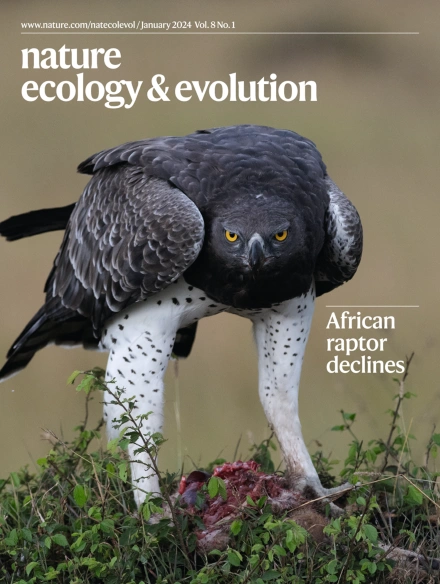将信息流嵌入生态网络
IF 13.9
1区 生物学
Q1 ECOLOGY
引用次数: 0
摘要
自然群落通过相互作用形成物种网络。了解这些生态网络的结构和动态是预测全球变化下物种灭绝风险、群落稳定性和生态系统功能的关键。传统上,生态网络研究的重点是涉及物质和能量流动的相互作用,如取食或授粉。然而,在自然界中,物种也通过有意或无意地交换影响其行为和运动的信息信号和线索来相互作用。在这里,我们认为物种之间的信息交换构成了一个自然的信息网络,这是社区组织中一个至关重要但在很大程度上被忽视的方面。我们建议在多层网络中整合信息与物质流相互作用。这种整合揭示了一种基于信息发送者和接收者如何嵌入食物网主题的信息链接的新分类。我们表明,在多层网络中合成信息和物质流相互作用可以导致更短的物种连接路径和更密集的物种聚集在更少的模块中。最终,物种之间的紧密联系增加了扰动在自然群落中传播的风险,从而破坏了它们的稳定性。因此,了解自然界的信息网络对于预测全球变化时代的群落动态至关重要。本文章由计算机程序翻译,如有差异,请以英文原文为准。


Embedding information flows within ecological networks
Natural communities form networks of species linked by interactions. Understanding the structure and dynamics of these ecological networks is pivotal to predicting species extinction risks, community stability and ecosystem functioning under global change. Traditionally, ecological network research has focused on interactions involving the flow of matter and energy, such as feeding or pollination. In nature, however, species also interact by intentionally or unintentionally exchanging information signals and cues that influence their behaviour and movement. Here we argue that this exchange of information between species constitutes an information network of nature—a crucial but largely neglected aspect of community organization. We propose to integrate information with matter flow interactions in multilayer networks. This integration reveals a novel classification of information links based on how the senders and receivers of information are embedded in food web motifs. We show that synthesizing information and matter flow interactions in multilayer networks can lead to shorter pathways connecting species and a denser aggregation of species in fewer modules. Ultimately, this tighter interconnectedness of species increases the risk of perturbation spread in natural communities, which undermines their stability. Understanding the information network of nature is thus crucial for predicting community dynamics in the era of global change. Ecological network research has typically focused on flows of matter and energy, but species also exchange information signals and cues that influence behaviour and movement. This Perspective argues that the information network of nature is a crucial aspect of community organization.
求助全文
通过发布文献求助,成功后即可免费获取论文全文。
去求助
来源期刊

Nature ecology & evolution
Agricultural and Biological Sciences-Ecology, Evolution, Behavior and Systematics
CiteScore
22.20
自引率
2.40%
发文量
282
期刊介绍:
Nature Ecology & Evolution is interested in the full spectrum of ecological and evolutionary biology, encompassing approaches at the molecular, organismal, population, community and ecosystem levels, as well as relevant parts of the social sciences. Nature Ecology & Evolution provides a place where all researchers and policymakers interested in all aspects of life's diversity can come together to learn about the most accomplished and significant advances in the field and to discuss topical issues. An online-only monthly journal, our broad scope ensures that the research published reaches the widest possible audience of scientists.
 求助内容:
求助内容: 应助结果提醒方式:
应助结果提醒方式:


